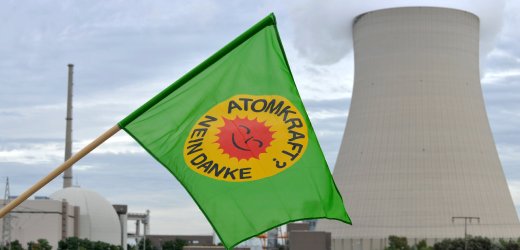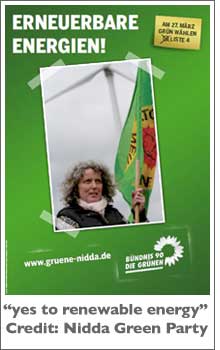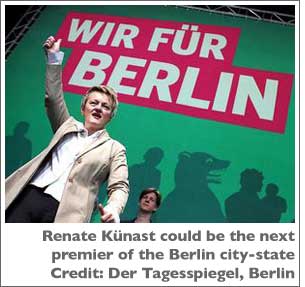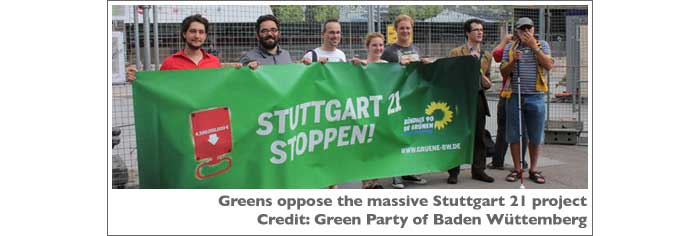German Greens flying high as nuke era ends
Share

by Phil Hill, Bündnis ‘90/Die Grünen (German Green Party)
By the end of July 2011, the chancellor of the world’s most advanced major industrial country signed a law making nuclear power illegal in ten years. Of the country’s 17 nuclear power plants, eight have been recently shut down and the rest will follow, about one a year, by 2022.
That country is Germany, the world’s fourth largest economy, and by far the healthiest of the four. When British Premier David Cameron recently asked German Chancellor Angela Merkel how Germany managed to do so well in the post-melt-down world, her answer was “We still make things.” Not “products,” like packages of upside-down mortgages and junk bonds. Things, like machines the whole world buys. Germany’s promise to itself and to the world is: no nukes and no coal.
 And yet, Germany is shutting down nuclear power. If the U.S. did that, the air conditioners would go out at Goldman Sachs. In Germany, according to pro-nuke propaganda, the machines should stop running at Siemens. But they won’t – and that is in no small part thanks to the fact that the Greens, when they were in government here, laid the foundation for a massive alternative energy program.
And yet, Germany is shutting down nuclear power. If the U.S. did that, the air conditioners would go out at Goldman Sachs. In Germany, according to pro-nuke propaganda, the machines should stop running at Siemens. But they won’t – and that is in no small part thanks to the fact that the Greens, when they were in government here, laid the foundation for a massive alternative energy program.
Moreover Germany is not, like the U.S., the big blocker in the worldwide fight against climate change, but a country that has that fight at the top of its foreign policy agenda — even if Merkel’s conservative-liberal government is not exactly practicing what it preaches. Germany’s promise to itself and to the world is: no nukes and no coal.
Alliance 90/The Greens, the world’s leading Green Party, plans to make good on that promise. First, they have to unseat Merkel — which they will in two years, at the latest, according to all polls. Then, Germany will be living proof that the “Green dream” of a good life powered by the sun and wind is possible. Possible in other industrial countries too; possible even as an alternative development path worldwide.
In 1999, a coalition of the Social Democrats (SPD) and Greens ran the country and passed the Nuclear Phase-Out Law, stipulating a 20-year nuclear shut-down, but — thanks to the pro-nuke faction in the SPD — it was full of loopholes. By last year, only one plant had actually been closed, and the nuclear industry’s stalling was paying off, for Merkel’s conservative-liberal coalition, elected in 2009 passed a bill stretching the phase-out date to 2040 or even later, and raising the specter of “safe nuke” research. The movement responded with huge demonstrations, the Greens’ support soared, and the law was challenged before the Constitutional Court. And then came Fukushima.
Back came nightmares about the Chernobyl disaster. Again, pictures of smoldering, radioactive ruins that had once been reactors; again, refugees abandoning their villages; again, reports of workers being sent in to fight a battle that would surely mean their agonizing death in a few months or years. Merkel began to waffle, and, after losing a state election to the Greens in the key state of Baden-Württemberg, caved in and introduced the new law that is soon to come into effect.
But all has not gone smoothly. One objection is that Germany was “going it alone;” another, that it will end up importing French or Czech nuclear power. The first has been given the lie by a similar, but less forceful move by Switzerland, and by a 95 percent popular referendum vote against nuclear power in Italy, confirming a post-Chernobyl decision. Together with smaller countries that have long ago said “no” to nukes — Austria, Luxemburg, Denmark, Norway and Iceland (and maybe Sweden and Belgium, which have vacillated on the issue) — there is thus a big anti-nuke block in central Europe of up to 200 million people, with the ability to exert strong influence on the pro-nuke countries to the west and the east.
Yet it is true that nuclear power may in fact be imported sporadically, since the European grid is integrated, and power flows to where it is needed. But the old SPD-Green government had also provided so much incentive for wind and solar power that these resources are growing fast enough to replace nuclear. That policy has continued under Merkel, albeit not optimally; Germany’s powerful environmental NGOs have a catalogue of demands for improving the law, that would mean a much greater share of alternative production by 2020. But since wind power, concentrated in the northern plain or offshore in the North and Baltic Seas, will be the primary source, while Germany’s main population and industrial centers are in the south and west, it is obvious that more long-distance power lines are needed — and they are highly controversial, often opposed by local Greens. The Greens are realizing they will have to bite the bullet and accept some projects. Another possibility advocated by local activists is the use of underground high-voltage direct-current (HVDC) power lines, which provide point-to-point transmission of large quantities of electricity to high-use centers.
 HVDC cables could also be used for the so-called Desertech project, for sending large quantities of solar power from the Mediterranean area to northern Europe. Backed by corporations like Siemens, and the Moroccan government, it already boasts large-scale solar plants in Morocco and Spain, and is a major hope for the future of the “Arab awakening.” But it is highly controversial among left and alternative forces — including Greens.
HVDC cables could also be used for the so-called Desertech project, for sending large quantities of solar power from the Mediterranean area to northern Europe. Backed by corporations like Siemens, and the Moroccan government, it already boasts large-scale solar plants in Morocco and Spain, and is a major hope for the future of the “Arab awakening.” But it is highly controversial among left and alternative forces — including Greens.
Electorally, the Greens are at an all-time high. In six state elections last year and this, they rose from seats in only four legislatures, and government participation in only one; to representation in all six state houses, and in four governments — including for the first time ever, a state premiership. In the Berlin state elections, scheduled for September, an SPD-Green government is a virtual certainty (currently, the SPD governs with the Left Party, the former East German communist party, which is going through a bad spell), and the only question is whether the SPD or the Greens will come in first.
If the Greens do, former Consumer Affairs Minister Renate Künast will run the nation’s capital. In Mecklenburg, a three-way coalition of the SPD, the Greens and the Left Party is possible, and next year, an SPD-Green win is likely in Schleswig-Holstein.
 Moreover the Merkel government is floundering badly; under the German parliamentary system it could fall apart, which would mean a federal election long before the scheduled September 2013 date. For the past year, the SPD and the Greens have been running around 25 percent each in national polls — so here too, a majority is likely, and who comes in first is the question. For the first time, a Green chancellor is possible — most likely former Environment Minister Jürgen Trittin.
Moreover the Merkel government is floundering badly; under the German parliamentary system it could fall apart, which would mean a federal election long before the scheduled September 2013 date. For the past year, the SPD and the Greens have been running around 25 percent each in national polls — so here too, a majority is likely, and who comes in first is the question. For the first time, a Green chancellor is possible — most likely former Environment Minister Jürgen Trittin.
Winfried Kretschmann, the new Green premier of Baden-Württemberg, can now show that the Greens can function as senior partners in government as well. In the state that is home to both Mercedes and Porsche, he shocked the public by saying that “fewer cars are of course better than more cars.” At least, he wants more electric cars and more wind power in a state that has been Germany’s nuclear stronghold — although two plants have already been shut down. And he has raised the possibility of locating Germany’s nuclear waste dump in the massive layers of clay of the southwest, which are well suited to seal off the nuclear legacy. The conservative rulers of the big southern states have until now taken a NIMBY position here, supporting the demonstrably unsafe proposed dump in the leaky salt deposits at Gorleben, Lower Saxony (in the north) — or, as an alternative, exporting the stuff to Russia.
One big challenge to Kretschmer is the Stuttgart railway station project, opposed as expensive and unviable by a large citizens’ movement. The Greens have promised to block it, but their SPD partners support it; now, a special study is going on to determine its viability.
 In both these issues, the Greens’ position in government has forced them into uncomfortable compromises. If for example, the Stuttgart station passes its viability test and also survives a popular referendum, the Green-led government will have to ensure that it is built — even in the face of massive demonstrations by its own supporters.
In both these issues, the Greens’ position in government has forced them into uncomfortable compromises. If for example, the Stuttgart station passes its viability test and also survives a popular referendum, the Green-led government will have to ensure that it is built — even in the face of massive demonstrations by its own supporters.
And the nuclear power compromise has already happened in the phase-out law, for the Greens had wanted to shut down the nukes within one electoral term — by 2017. But Merkel’s bill extended the phase-out for five years longer — largely because that’s when the last nukes will be amortized; probably, the corporations threatened to sue, should the law force them to shut down functional plants, which had not even paid for themselves.
At a quickly assembled national party congress in Berlin in June, the Greens leadership asked the party to abandon the 2017 promise and support he law, since they could not realistically change it again, even after the next election, and they wanted to send the signal that the Greens accepted their own victory over the nuclear menace and were willing to work to implement alternatives. Opponents called for support only under the condition that the government change the bill significantly — which Merkel would not have done, leaving the Greens to, in effect, vote against a bill to shut down nuclear power. After a lengthy and heated debate, the proponents narrowly won the day, and the Greens voted for the bill in the Bundestag, while rejecting a number of ancillary bills — which they hope to change again after the next election. The question then will be how to design a long-term future for Germany — and Europe — without nuclear power, and with a clear commitment to the fight against climate change.








Please send to Phil Hill:
From Haitian-American Green (1985–1990)
We knew each other at the time when the Green Committees of Correspondence was organizing for a Green Movement and Party in the U.S. I then became a founding member of The Other Economic Summit in the U.S. and was active with the 50 Years Is Enough Campaign. I now run Green Cities–Green Villages, a green incubator focused on technology transfer of renewables to Haiti and Africa, with some projects also in the U.S. Am in the process of writing my memoirs and would like to be in touch with you to compare notes about the Green Movement, though I’m no longer active in the “political” wing of it.
I now live in New Haven, CT and travel frequently to New York City where I have many NGO clients. Please feel free to contact me at the above email address. Are you still living in Germany? Do you travel frequently to the U.S.?
Best for the New Year. Yanique